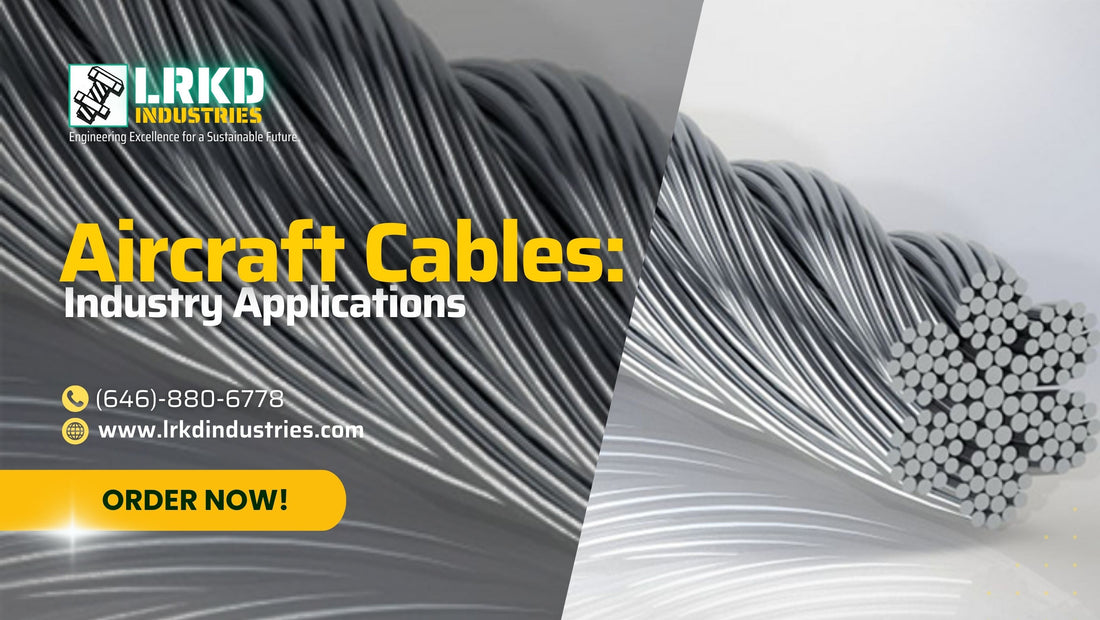In the ever-evolving world of engineering and construction, few components offer as much versatility and reliability as aircraft cables. These high-strength, precision-engineered wires play a pivotal role in numerous industries, providing solutions for critical applications. What makes them indispensable, and how are they utilized across sectors? Let’s explore.
What Are Aircraft Cables?
Aircraft cables, also known as wire ropes, are composed of multiple strands of stainless steel or galvanized steel wires twisted into a helix. Their unique construction provides exceptional flexibility, strength, and resistance to wear, making them ideal for dynamic and static applications.
Core Types:
Fiber Core (FC): Offers flexibility and shock absorption.
Independent Wire Rope Core (IWRC): Adds strength and durability.
Material Options:
Stainless steel: Excellent corrosion resistance.
Galvanized steel: Cost-effective with moderate corrosion resistance.
Sizes and Strengths:
Typical diameters range from 1/16 inch to 3/8 inch. Breaking strengths can exceed 14,000 pounds, depending on the configuration.
|
Property |
Stainless Steel |
Galvanized Steel |
|
Corrosion Resistance |
High |
Moderate |
|
Flexibility |
Moderate |
High |
|
Cost |
Higher |
Lower |
Applications Across Industries
1. Aerospace and Aviation
Aircraft cables are indispensable in aviation, where precision and safety are non-negotiable.
Flight Control Systems: They transmit pilot commands to control surfaces like rudders and ailerons.
Aircraft Safety Mechanisms: Cables support emergency exits, cargo doors, and parachute deployments.
Example: Boeing, a leader in aerospace engineering, employs stainless steel aircraft cables in their control systems for optimal performance and durability in extreme conditions.
2. Construction and Architecture
In the construction world, aircraft cables shine as both functional and aesthetic components.
Suspension Bridges: High-tension cables provide structural support.
Architectural Features: Often used in railing systems, they combine strength with sleek, modern aesthetics.
Case Study: In 2017, the San Francisco Bay Area’s pedestrian bridge incorporated stainless steel aircraft cables for its railings. These cables offered durability while maintaining an unobstructed view of the bay.
3. Marine and Offshore Industries
The harsh marine environment demands materials that resist corrosion and wear—qualities that make aircraft cables a natural fit.
Mooring Lines: Securing vessels and offshore platforms.
Rigging and Lifting: Used for cranes and other heavy-duty equipment.
Real-Life Example: The offshore wind farms in the North Sea rely on galvanized steel aircraft cables to moor turbines securely, ensuring uninterrupted energy generation.
4. Entertainment and Stage Rigging
Behind the scenes in theaters and stadiums, aircraft cables play a supporting role in creating magic.
Stage Rigging: Elevating lights, scenery, and sound equipment.
Safety Harnesses: Used in stunts and aerial performances.
Fun Fact: Cirque du Soleil’s productions use aircraft cables for aerial acrobatics, ensuring both performance excellence and performer safety.
5. Industrial and Manufacturing Equipment
Aircraft cables are widely used in equipment requiring precision and reliability.
Conveyor Systems: Ensuring smooth and efficient operation.
Lifting and Hoisting: Heavy-duty tasks in warehouses and factories.
Example: Major logistics centers like Amazon’s fulfillment warehouses use aircraft cables in conveyor systems for durability and efficiency.
Advantages of Aircraft Cables
Why are aircraft cables so widely used? Their unmatched properties make them a go-to solution across diverse sectors:
High Strength-to-Weight Ratio: Handles substantial loads without adding unnecessary weight.
Flexibility: Can be used in dynamic applications where movement and vibration occur.
Corrosion Resistance: Essential for marine and outdoor environments.
Longevity: Engineered to withstand repeated stress and harsh conditions.
Choosing the Right Aircraft Cable
Selecting the appropriate cable for your application involves considering key factors:
Environment: Stainless steel for corrosive environments; galvanized steel for dry conditions.
Load Requirements: Calculate the working load limit (WLL) based on expected stress.
Flexibility vs. Strength: More strands offer flexibility; fewer strands enhance strength.
Aircraft Cable Solutions for Industrial Applications
Save your team valuable time and resources! Whether you're in the middle of a build or preparing a proposal, LRKD Industries offers a comprehensive take-off service specifically for aircraft cables—tailored to your project’s exact specifications and schematics. This is the perfect solution for teams who demand precise, fast material estimates without the hassle of manual calculations.
Contact LRKD Industries now for this time-saving service!
👉 Submit your plans today for a FREE consultation and aircraft cable take-off evaluation.
📍 Address: 98 N Industry CT, Deer Park, NY 11729, US
📞 Phone: +1 646-880-6778
📧 Email: info@lrkdindustries.com
We can also convert your project files into .dwg format compatible with Tekla, making integration with your modeling and fabrication processes seamless.
Want to explore our full range of aircraft cable assemblies and fittings? Click here for more details.
When safety and strength are critical, precision isn't just important—it’s mission-critical.


